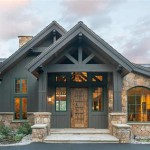1400 Sq Ft House Plans: One-Story Living
The concept of single-story living has gained significant traction, appealing to a wide demographic, including families, retirees, and individuals seeking accessibility or ease of maintenance. Among the popular choices for this type of dwelling are 1400 sq ft house plans. These plans offer a balanced blend of spaciousness and manageability, making them a viable option for various lifestyle needs and lot sizes. This article delves into the considerations, advantages, and common design elements associated with 1400 sq ft one-story house plans.
When considering a one-story house plan, the available land becomes a crucial factor. Unlike multi-story homes that can utilize vertical space to minimize the footprint, a one-story design requires a larger plot for the same square footage. Site orientation also plays a significant role. The placement of windows and rooms should be carefully considered to maximize natural light and minimize heat gain, particularly during peak sunlight hours. Local building codes and zoning regulations must be strictly adhered to, dictating setbacks, height restrictions, and other parameters that may influence the design and placement of the house.
Furthermore, understanding the household's present and anticipated needs is essential. The number of bedrooms and bathrooms required, the importance of dedicated home office space, and the need for specialized areas like workshops or hobby rooms will all impact the floor plan. Accessibility considerations, such as wider doorways, ramp access, and adaptable bathrooms, should be prioritized if the home is intended for individuals with mobility limitations or for aging in place. Storage needs, often underestimated, should also be carefully assessed to prevent clutter and maintain an organized living environment. These factors, along with aesthetic preferences, will shape the final design of the 1400 sq ft home.
Advantages of a 1400 Sq Ft One-Story House
The advantages of choosing a one-story home, particularly within the 1400 sq ft range, are numerous. Accessibility is a primary benefit. The absence of stairs eliminates the risk of falls, making the home safer for young children, older adults, and individuals with mobility impairments. This simplifies daily tasks and promotes independent living for a longer period.
Construction and maintenance also tend to be simpler and more cost-effective with a one-story design. Building a single-level structure requires less complex framing and foundation work compared to multi-story homes. This can translate to lower construction costs and faster build times. Similarly, maintenance tasks such as roof repairs, gutter cleaning, and exterior painting are easier and safer to perform on a single-story house. Interior maintenance is also simplified, as there are no stairs to clean or carpets to vacuum on multiple levels.
Furthermore, one-story homes often offer better energy efficiency due to reduced air leakage between floors and a more consistent temperature distribution throughout the house. Heating and cooling systems don't have to work as hard to compensate for temperature variations between levels, resulting in lower energy bills. The design can also promote better indoor air quality by minimizing the circulation of dust and allergens between floors.
Finally, single-story living can foster a greater sense of connection and togetherness within the family. With all living spaces on one level, family members are more likely to interact and spend time together. This can be especially beneficial for families with young children or elderly relatives who require close supervision. The open floor plans often associated with one-story designs further enhance this sense of connection and create a more inviting and social atmosphere.
Key Design Elements in 1400 Sq Ft One-Story House Plans
Several key design elements contribute to the functionality and appeal of 1400 sq ft one-story house plans. Open floor plans are frequently incorporated, combining the living room, dining area, and kitchen into a single, unified space. This creates a sense of spaciousness and allows for flexible furniture arrangements. It also enhances natural light penetration and facilitates social interaction.
Thoughtful zoning is crucial to ensure both privacy and functionality. The bedrooms are typically grouped together in one area of the house, separated from the main living spaces. The master suite often includes a private bathroom and walk-in closet, providing a secluded retreat. Mudrooms or entryways are strategically located near entrances to help contain clutter and provide a space for removing shoes and outerwear. Laundry rooms are typically situated near the bedrooms for convenience.
Ample storage is another critical design consideration. Built-in shelving, closets, and cabinets are incorporated throughout the house to maximize storage space and minimize clutter. Attics or crawl spaces can also be utilized for additional storage, although accessibility should be carefully considered. The garage, if included, can also provide storage space for tools, equipment, and seasonal items.
Outdoor living spaces are often integrated into the design. Patios, decks, and porches extend the living area beyond the interior walls, providing spaces for relaxation, entertainment, and outdoor dining. Covered porches can offer shade and protection from the elements, allowing for year-round enjoyment of the outdoors. Landscaping is carefully planned to enhance the curb appeal and create a private and inviting outdoor environment.
Attention to detail in the interior finishes and fixtures can significantly impact the overall aesthetic and functionality of the home. High-quality flooring, countertops, and cabinetry can enhance the visual appeal and durability of the space. Energy-efficient appliances and lighting fixtures can reduce energy consumption and lower utility bills. Thoughtful selection of colors, textures, and patterns can create a cohesive and inviting interior design.
Floor Plan Configurations and Room Allocation
The configuration of rooms within a 1400 sq ft one-story house varies depending on the priorities and lifestyle of the homeowner. A common configuration includes three bedrooms and two bathrooms, along with a combined living room, dining area, and kitchen. This layout provides ample space for a small family or a couple who enjoys having guest rooms. Alternatively, a two-bedroom, two-bathroom layout can offer larger bedrooms or a more spacious living area.
The kitchen design is often a focal point, with islands, breakfast bars, and ample counter space. Open kitchens facilitate social interaction and allow for easy meal preparation. The living room is typically designed as a comfortable and inviting space for relaxation and entertainment, often featuring a fireplace or entertainment center. The dining area can be either formal or informal, depending on the homeowner's preferences.
Bedroom sizes can vary depending on the overall layout. The master suite typically includes a larger bedroom, a private bathroom, and a walk-in closet. Secondary bedrooms are usually smaller, but still offer adequate space for sleeping, studying, and storage. Bathrooms can range from simple powder rooms to luxurious master bathrooms with soaking tubs and separate showers.
Flex spaces are becoming increasingly popular in modern house plans. These spaces can be used as home offices, playrooms, guest rooms, or hobby rooms, depending on the homeowner's needs. Flex spaces provide flexibility and adaptability, allowing the home to evolve with the changing needs of the family. The allocation of square footage to each room should be carefully considered to ensure that the house meets the homeowner's needs and lifestyle requirements.
In conclusion, 1400 sq ft one-story house plans offer a compelling option for those seeking a balance of space, accessibility, and manageability. Careful consideration of site conditions, household needs, and desired design elements is crucial to creating a functional and aesthetically pleasing home. The advantages of single-story living, including accessibility, ease of maintenance, and energy efficiency, make these plans a popular choice for a wide range of homeowners.

Plan 59002 1400 Square Foot Ranch House Country Design A

Single Floor Home Plan In 1400 Square Feet

House Plan 40686 Ranch Style With 1400 Sq Ft 3 Bed 2 Bath Coolhouseplans Com

Contemporary Plan 1 400 Square Feet 3 Bedrooms 2 Bathrooms Floor 048 00301 America S Best House Plans

1400 Square Foot Contemporary Farmhouse Plan With 27 Deep 2 Car Garage 85396ms Architectural Designs House Plans

Plan 5700ha 1400 Square Foot 3 Bed Ranch House With 5 Columned Front Porch

Ranch Style House Plan 3 Beds 2 Baths 1400 Sq Ft 312 356 Houseplans Com

House Plan 1400 The Andrew European

Farmhouse Style House Plan 3 Beds 2 Baths 1400 Sq Ft 57 701 Houseplans Com

Contemporary Plan 1 400 Square Feet 3 Bedrooms Bathroom Floor 034 01278 America S Best House Plans








